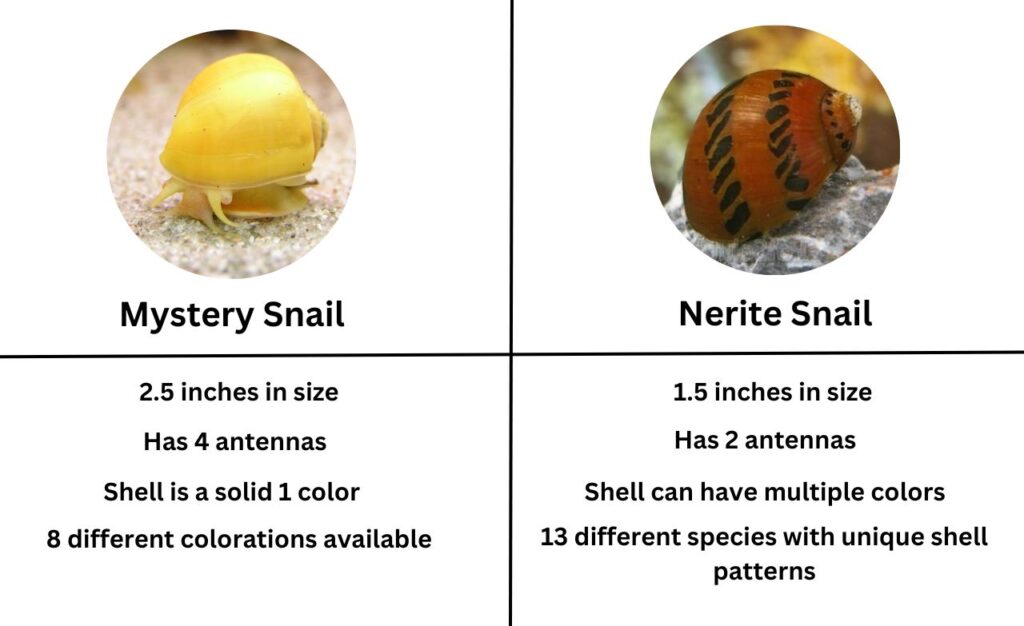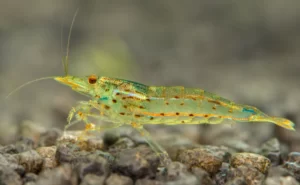
Nerite vs Mystery Snail: Differences & Similarities Explained

Writer at The Aquarium Keeper
Sometimes it can be hard for a beginner fish keeper to tell the difference between two different aquatic species. This also might be the case with nerite and mystery snails. Both species are very popular and widely available, so it is important to understand the key differences between nerite and mystery snails. In this article, I will breakdown the nerite vs mystery snail topic, highlighting key similarities and differences between these two amazing aquatic snails.
Nerite vs Mystery Snail
Nerite snails and mystery snails originate from different parts of the world. These species are completely different snails, but do enjoy tropical climates, and can easily coexist in the same aquarium. Mystery snails mainly come from South America, and their main habitat is the Amazon River.

Nerite snails are a more diverse species since there are so many types of nerite snails available all around the world. Different species are found in Africa, and the coastlines of the Pacific, Atlantic, and Indian Oceans.
Physical Appearance
Nerite snails often have more than 1 color on their shell. They often have dots, stripes, or even horns on their shell, making these species one of the most interesting aquatic snails in this hobby. Nerites are very different in terms of appearance compared to mystery snails.

Nerite snails are smaller species, and can only reach about 1.5 inches (4 cm) when fully matured. Nerites also have only 2 antennas at the top of their head, which allows them to navigate their surroundings. These species also have smaller mouths compared to mystery snails.
Mystery snails are larger, and can even reach 3 inches (7.62 cm) when fully grown. There are a lot of different mystery snail colors, but every mystery snail has a solid 1-colored shell. These species don’t have mixed-color shells like nerites, and that is the main difference in terms of appearance.

Another important thing is that different mystery snails are often different in body color too, while nerite snails are always dark grey in body coloration. Mystery snails also have 4 antennas, 2 at the top of their head and 2 near their mouth, which help scavenge for food.
Tank Conditions
Moving on, nerite and mystery snails both need an aquarium, that is at least 5 gallons large. The tank should include live plants, a filter, a heater, and lightning. Live plants are necessary, if you want your aquarium water to be more clean, and they are visually appealing too. A filter is needed to also ensure the quality of water, which can get dirty even from aquatic snails.
The best aquarium conditions for nerite snails are:
- Water Temperature: 20–26 °C (60–79 °F)
- pH: 6.0–8.0
- Water Hardness: 60—200 ppm
- Minimum Tank Size: 5 gallons
- Weekly Water Changes: 10–15%
- Lightning intensity: Low to high
The best aquarium conditions for mystery snails are:
- Water Temperature: 15–30 °C (59–86 °F)
- pH: 6.5–8.0
- Water Hardness: 100—200 ppm
- Minimum Tank Size: 5 gallons
- Weekly Water Changes: 10–15%
- Lightning intensity: Low to high
As you can see, both species like slightly different water temperatures, but they could easily coexist in the same tank, since both are considered to be tropical aquatic snails.
Behaviour
Behavior is an important aspect when choosing an aquatic pet to add to an aquarium. Nerite and mystery snails tend to be very peaceful creatures, that do not harm any other living aquatic species. Nerite snails are less physically active and tend to stay in one place far more. Mystery snails are the more curious species out of these two, often climbing every decoration that they can, and occasionally falling off plants into the bottom of the tank.
Diet
Both species are considered to be partly omnivorous and herbivorous. Here is the list of things that both nerite and mystery snails gladly eat:
- Algae
- Leftover fish food
- Blanched vegetables (zucchini, carrots, spinach, lettuce)
- Decaying plant matter
- Algae wafers
- Bloodworms
- Phytoplankton
- Deceased tank mates
Nerite and mystery snails are both scavengers and opportunists. If they find any type of food lying around in an aquarium (including deceased tank mates), they will try to eat it. These species are not too picky when it comes to food.
Tank Mates
Nerite and mystery snails can live with the same peaceful tank mates, including small nano fish like neon tetras, celestial pearl danios, chili rasboras, invertebrates like neocaridina or amano shrimp, and other peaceful snails.
You should not house your nerite or mystery snails with certain fish, that portray aggressive behavior towards other creatures. Here are the following tank mates that don’t do well with nerite or mystery snails:
- Pea puffer
- Betta fish
- Larger gourami species
- Cichlids
- Goldfish species
These types of fish often are aggressive towards snails, some due to territorial purposes, and others simply see snails as food. Try avoiding these species and instead keep nerite or mystery snails with small nano fish, small invertebrates, or other snails.
Reproduction
Nerite snails are known for laying eggs all over the tank. One annoying thing about these species is that they sometimes ruin the view with their eggs everywhere. Unfortunately, nerite snail eggs don’t hatch in freshwater, and to successfully breed nerite snails, you would need brackish water. So it is safe to say that you would not end up with more nerite snails, as they don’t reproduce in freshwater.
On the other hand, mystery snails do reproduce in freshwater, by laying a clutch of eggs at the top of the water line in an aquarium. If there is enough humidity and moisture, the eggs will hatch in 1-2 weeks. There are instances, when there are infertile mystery snail eggs at the top of the tank, and that is the case of a male not being present in the tank. To successfully breed mystery snails, you would need a separate breeding tank, ideal water parameters, and both males and females in the aquarium.
Diseases
Both nerite and mystery snails can suffer from the same diseases and problems. Leading factors of these problems can be poor water quality, stress, and bad diet. Here are the common problems, that can occur to nerite and mystery snails:
Cracked or chipped shell – Snails often develop cracks or chips on their shells. This can be a reason for physical injury (falling, attack from fish), but at the same time from poor water quality and nutritional deficiency. Make sure to house your snails with good tank mates, check your water quality with a test kit, feed your snails quality food, and do frequent water changes.
Sensitivity to metals – Nerite and mystery snails are really sensitive to certain metals, especially copper. Concentrations as low as 0.01% can seriously harm these snails, so make sure to test your water with a test kit.
Parasites – Snails can also easily get sick just like humans. Lack of movement, loss of appetite, or some other visual problems can be the cause of internal or external parasites. A basic salt bath usually solves this problem.
All of these problems can easily lead to a dead snail in a fish tank. Nobody wants to deal with a dead snail, so be sure to take proper care of your snails.
Frequently Asked Questions
Can Mystery Snails Live With Nerite Snails?
Mystery and nerite snails can definitely live together. Both species are peaceful, like the same food, and enjoy similar water conditions.
Can Nerite And Mystery Snails Breed?
Nerite and mystery snails can’t breed with one another. Both snails are completely different species, that need certain conditions to breed, and they can’t do it with one another in any way.
Writer's Thoughts
To sum things up, both species are absolutely amazing, and I would definitely recommend keeping nerite and mystery snails in the same tank. In this way, you would actually see the differences in your own eyes, and it would help you decide, which snail you like more.
If you enjoyed reading our article, please feel free to share it with your friends by clicking the social media buttons below:





